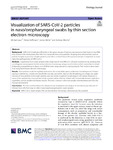2023-02-06Zeitschriftenartikel
Visualization of SARS-CoV-2 particles in naso/oropharyngeal swabs by thin section electron microscopy
Laue, Michael
Hoffmann, Tobias
Michel, Janine
Nitsche, Andreas
Background
SARS-CoV-2 replicates efficiently in the upper airways of humans and produces high loads of virus RNA and, at least in the initial phase after infection, many infectious virus particles. Studying virus ultrastructure, such as particle integrity or presence of spike proteins, and effects on their host cells in patient samples is important to understand the pathogenicity of SARS-CoV-2.
Methods
Suspensions from swab samples with a high load of virus RNA (Ct < 20) were sedimented by desktop ultracentrifugation and prepared for thin section electron microscopy using a novel method which is described in detail. Embedding was performed in Epon or in LR White resin using standard or rapid protocols. Thin sections were examined using transmission electron microscopy.
Results
Virus particles could be regularly detected in the extracellular space, embedded in a background of heterogenous material (e.g. vesicles and needle-like crystals), and within ciliated cells. Morphology (i.e. shape, size, spike density) of virus particles in the swab samples was very similar to particle morphology in cell culture. However, in some of the samples the virus particles hardly revealed spikes. Infected ciliated cells occasionally showed replication organelles, such as double-membrane vesicles. The most common cells in all samples were keratinocytes from the mucosa and bacteria.
Conclusions
The new method allows the ultrastructural visualization and analysis of coronavirus particles and of infected host cells from easy to collect naso/oropharyngeal patient swab samples.
Files in this item

